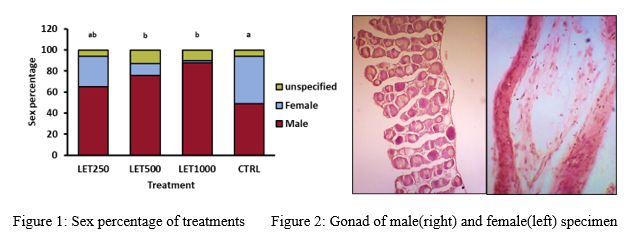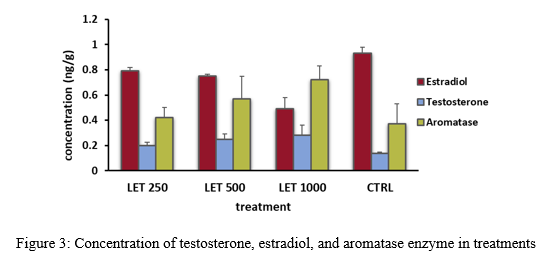UTILIZING AROMATASE ENZYME INHIBITOR AIMING TO PRODUCE NEOMALE RAINBOW TROUT Oncorhynchus mykiss VIA IMMERSION METHOD DURING LARVAL STAGE
Introductions
Female rainbow trout possess characteristics that motivate breeders to produce all-female populations via producing neomale broodstock (Wang et al., 2018). Steroid hormones, steroid-like plant compounds , as well as some drugs, can cause the sex reversal process in fish through various methods such as oral administration, immersion, injection, or implantation. The current study aimed to administer Letrozole , an aromatase enzyme inhibitor, at the start of sex differentiation stage of rainbow trout for sex reversal via the immersion method at the labile period (Piferrer , 2001). Letrozole is known as a non-steroidal competitive inhibitor of the aromatase enzyme system, preventing the conversion of testosterone to e stradiol in the pathway of steroidogenesis (Weber et al., 2020).
Materials and Methods
The eyed-eggs of rainbow trout were immersed in 250, 500, and 1000 μg/L letrozole for 2 hours. This procedure was repeated five times at two-week intervals (Katare et al., 2015 ; Shen et al., 2015). At the end of the exposure period, f ish were sampled to evaluate sex steroid hormones as well as aromatase levels using the ELISA method (Diotel et al., 2010). Sex determination was performed at a weight of about 20 grams using the hematoxylin-eosin staining method. The survival rate of treatments and the malformations of the spine, eyes, and jaw were recorded up to 1 gram in weight. One-way ANOVA and Duncan’s test were employed to assess the significance of the difference between the means (Tan et al., 2020).
Results
The results of sex determination indicated that the highest rate of masculinization was achieved for treatments LET1000 and LET500, with 88 and 83 percent male fish, respectively.
The highest level of estradiol was observed in CTRL on day 80 and the lowest level was measured in treatment LET1000 . The concentration of testosterone in treatment LET1000 was higher than in other treatments and the concentration of aromatase enzyme in all experimental treatments was higher than control, with the highest amount in LET1000.
Treatment LET1000 exhibited the highest deformity among the experimental treatments; however, this rate was not significantly different from that of the control group (P ≥ 0.05). Specifically, the rate of deformity in treatment LET250 was 5.2% (78 malformed larvae), in treatment LET500 it was 4% (60 malformed larvae), in treatment LET1000 it was 6.46% (97 malformed larvae), and in the control group (CTRL) it was 4.8% (72 malformed larvae).
Discussion
Results of the present study showed that letrozole is an effective drug for changing the sex of rainbow trout. Moreover, it can be considered as a substitute for methyltestosterone and has a positive impact on inhibiting aromatization, inhibiting estrogen synthesis, and increasing endogenous testosterone. This leads to the production of fish with a male phenotype in the populations treated with the drug.


